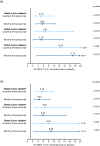Fremanezumab for the Preventive Treatment of Migraine: Subgroup Analysis by Number of Prior Preventive Treatments with Inadequate Response
- PMID: 33990144
- PMCID: PMC8411464
- DOI: 10.1177/03331024211008401
Fremanezumab for the Preventive Treatment of Migraine: Subgroup Analysis by Number of Prior Preventive Treatments with Inadequate Response
Abstract
Objective: To evaluate the efficacy of monthly or quarterly fremanezumab in patients with chronic migraine or episodic migraine and documented inadequate response to 2, 3, or 4 classes of prior migraine preventive medications.
Methods: This is an exploratory analysis of a randomized, double-blind, placebo-controlled, phase 3b trial for patients with chronic migraine or episodic migraine and inadequate response to 2 to 4 prior migraine preventive medication classes randomized (1:1:1) to fremanezumab (quarterly or monthly) or placebo. In this exploratory analysis, changes from baseline in the monthly average number of migraine days during 12 weeks of double-blind treatment and adverse events were evaluated for predefined subgroups of patients by number of prior preventive medication classes with inadequate response.
Results: Overall, 414, 265, and 153 patients had inadequate response to 2, 3, and 4 preventive medication classes, respectively. Changes from baseline in monthly average migraine days during 12 weeks were significantly greater with fremanezumab compared with placebo for patients with documented inadequate response to 2 classes (least-squares mean difference vs placebo [95% confidence interval]: quarterly, -2.9 [-3.83, -1.98]; monthly, -3.7 [-4.63, -2.75]), 3 classes (quarterly, -3.3 [-4.65, -1.95]; monthly, -3.0 [-4.25, -1.66]), and 4 classes (quarterly, -5.3 [-7.38, -3.22]; monthly, -5.4 [-7.35, -3.48]) of migraine preventive medications (all p < 0.001). No significant treatment-by-subgroup interactions were observed for any outcome (p interaction > 0.20 for all). Adverse events were comparable for placebo and fremanezumab.
Conclusion: Significant improvements in efficacy were observed with fremanezumab compared with placebo, even in patients who had previously experienced inadequate response to 4 different classes of migraine preventive medications.ClinicalTrials.gov identifier: NCT03308968.
Keywords: CGRP; Chronic migraine; episodic migraine; treatment failure.
Conflict of interest statement
Figures




Similar articles
-
Efficacy and safety of fremanezumab in patients with migraine and inadequate response to prior preventive treatment: subgroup analyses by country of a randomized, placebo-controlled trial.J Headache Pain. 2021 Apr 16;22(1):26. doi: 10.1186/s10194-021-01232-8. J Headache Pain. 2021. PMID: 33863272 Free PMC article. Clinical Trial.
-
Fremanezumab versus placebo for migraine prevention in patients with documented failure to up to four migraine preventive medication classes (FOCUS): a randomised, double-blind, placebo-controlled, phase 3b trial.Lancet. 2019 Sep 21;394(10203):1030-1040. doi: 10.1016/S0140-6736(19)31946-4. Epub 2019 Aug 16. Lancet. 2019. PMID: 31427046 Clinical Trial.
-
Reduction in the severity and duration of headache following fremanezumab treatment in patients with episodic and chronic migraine.Headache. 2021 Jun;61(6):916-926. doi: 10.1111/head.14127. Epub 2021 Jun 11. Headache. 2021. PMID: 34115380 Free PMC article. Clinical Trial.
-
Fremanezumab: a disease-specific option for the preventive treatment of migraine, including difficult-to-treat migraine.Emerg Top Life Sci. 2020 Sep 8;4(2):179-190. doi: 10.1042/ETLS20200018. Emerg Top Life Sci. 2020. PMID: 32832978 Free PMC article. Review.
-
Monthly versus quarterly fremanezumab for the prevention of migraine: a systemic review and meta-analysis from randomized controlled trials.Naunyn Schmiedebergs Arch Pharmacol. 2021 Apr;394(4):819-828. doi: 10.1007/s00210-020-02009-7. Epub 2020 Nov 2. Naunyn Schmiedebergs Arch Pharmacol. 2021. PMID: 33136176
Cited by
-
Real-world effectiveness of fremanezumab in migraine patients initiating treatment in the United States: results from a retrospective chart study.J Headache Pain. 2022 Apr 11;23(1):47. doi: 10.1186/s10194-022-01411-1. J Headache Pain. 2022. PMID: 35410121 Free PMC article.
-
Eptinezumab Demonstrated Efficacy Regardless of Prior Preventive Migraine Treatment Failure Type: Post Hoc Analyses of the DELIVER Study.Neurol Ther. 2024 Apr;13(2):339-353. doi: 10.1007/s40120-023-00575-5. Epub 2024 Jan 18. Neurol Ther. 2024. PMID: 38236314 Free PMC article.
-
Gender bias in clinical trials of biological agents for migraine: A systematic review.PLoS One. 2023 Jun 2;18(6):e0286453. doi: 10.1371/journal.pone.0286453. eCollection 2023. PLoS One. 2023. PMID: 37267250 Free PMC article.
-
Impact of a reimbursement policy change on treatment with erenumab in migraine - a real-world experience from Germany.J Headache Pain. 2023 Oct 30;24(1):144. doi: 10.1186/s10194-023-01682-2. J Headache Pain. 2023. PMID: 37899428 Free PMC article.
-
Pharmacokinetics and Safety of Erenumab after a Single Subcutaneous Injection Dose in Healthy Chinese Subjects.Clin Drug Investig. 2022 Jul;42(7):623-630. doi: 10.1007/s40261-022-01171-5. Epub 2022 Jun 21. Clin Drug Investig. 2022. PMID: 35727536 Clinical Trial.
References
-
- American Headache Society. The American Headache Society position statement on integrating new migraine treatments into clinical practice. Headache 2019; 59: 1–18. - PubMed
-
- Reuter U.A review of monoclonal antibody therapies and other preventative treatments in migraine. Headache 2018; 58: 48–59. - PubMed
-
- Bigal ME, Lipton RB.Overuse of acute migraine medications and migraine chronification. Curr Pain Headache Rep 2009; 13: 301–307. - PubMed
-
- Messali A, Sanderson JC, Blumenfeld AM, et al.. Direct and indirect costs of chronic and episodic migraine in the United States: a web-based survey. Headache 2016; 56: 306–322. - PubMed
Publication types
MeSH terms
Substances
Associated data
LinkOut - more resources
Full Text Sources
Other Literature Sources
Medical
Research Materials

